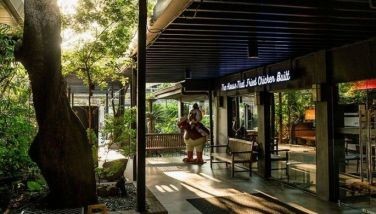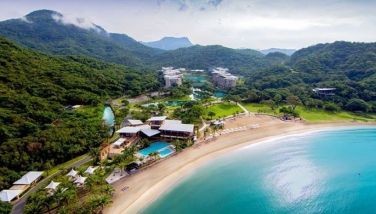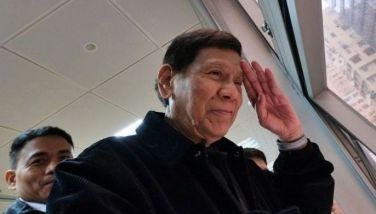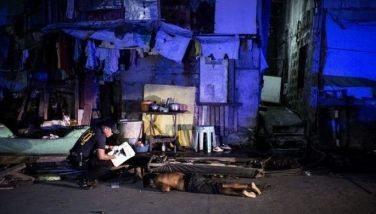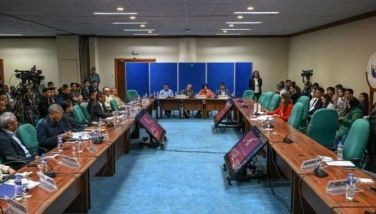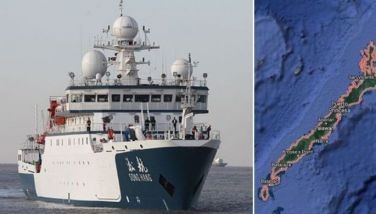PAF retires F-5 after 40 years of service
October 2, 2005 | 12:00am
BASA AIR BASE, Pampanga — After 40 years of guarding the nation’s airspace, the Philippine Air Force (PAF) is retiring its vanguard F-5 jet fighters that formed the core of its air defense and saw action against communist and Muslim rebels as well as military mutineers.
Short of saying this leaves the Philippines defenseless against external threats, the commander of the PAF Air Defense Wing bid farewell to the country’s aging F-5 fighters in sentimental rites that had a funereal tone.
"If a nation cannot contest air superiority, one wonders exactly how it can sustain a conventional army in the future battlefield," Air Force Brig. Gen. Manuel Natividad, commander of the Air Defense Wing, said in his speech at the 431 Maintenance Hangar here, where F-5 No. 191 was taxied out for a final view.
The PAF said the last 10 remaining fighters were too old and too expensive to maintain in view of the shift in military resources to tackling internal defense rather than external threats.
The first 23 brand-new jets were acquired in 1965 from the United States under a bilateral military assistance pact, making the Philippines the first Southeast Asian country to have supersonic fighters, making it the envy of its neighbors.
Since then the jets — also dubbed "Freedom Fighters" — have been used extensively to patrol areas claimed by the Philippines in the disputed Spratly island chain and the Scarborough Shoal in the South China Sea. They were also used by the famous PAF "Blue Diamonds" aerobatics team that wowed crowds in air shows nationwide in the 1960s and the 70s.
The jets were also used to back soldiers fighting communist insurgents in the central and northern Philippines and Muslim separatist rebels and the al-Qaeda-linked Abu Sayyaf group in the South. They blasted military rebel positions at an air base south of Manila during a coup attempt in 1989.
The whole F-5 fleet has been grounded since May 2001 following a crash of one of the jets during a joint military exercise with the US military.
The subsonic Augusta AS-211 jet trainer and light attack aircraft will temporarily perform external defense duties, the PAF said. It has 18 of these aircraft, though only six are serviceable.
Natividad lamented the PAF now has no actual jet fighter planes left to fly. "What are we going to fight with these fighters?" he asked, referring to the
Augusta AS-211s which will mainly be used for training student pilots.
Capt. Ephraim Suyom, spokesman for the Air Defense Wing here, said five of the remaining 10 F5s were still "serviceable" but all of them could be used "in case of war."
"In extreme emergency, you do what you have to do," he said.
The farewell ceremony was not without emotion.
"The decommissioning of the F-5 should bring to our attention the prevailing issues we are facing today," said Natividad. "For (this) will significantly affect the Air Force as an organization. Just like this aircraft, pilots who dedicate their life to flying fighter missions are (also) going away, seeking greener pastures.
"No, we are not clamoring for new hardware," he continued. "What we are concerned about is the transfer of knowledge and skills from one generation of pilots to another. Yes, it is true that countries across the globe are cutting on defense spending but the least affected by all these changes are their Air Forces."
He warned that the PAF, "on the other hand, runs counter to the trend. What good would it be for the future of the Armed Forces of the Philippines?"
Attending the ceremonies were 75-year-old retired Brig. Gen. Angel Okol, who was the first Filipino pilot to fly the PAF’s first F-5 back in 1965, as well as Maj. Carlos Evangelista — the last PAF pilot to do so before they were grounded.
A handout distributed during the ceremonies cited the defense planning guidance under US-RP Joint Defense Agreement (JDA) as saying that the F5 "is no longer economical to maintain and that internal security operations be given priority over external affairs." It noted that the aging fighter jets were obtained by the Philippines under the US-RP military assistance program (MAP).
Present during the historical event were PAF chief Lt. Gen. Jose Reyes as guest of honor and speaker and pioneer pilots of the F-5 and other US military dignitaries.
Natividad noted that Reyes was against the retirement of the F-5s, adding that Reyes "stood for us, for the simple reason that he continues to believe in the capability of this unit and of its personnel to get the job done no matter what."
Addressing Reyes, Natividad said "with your continued support, we are confident that the decision makers will eventually see the significance of keeping a fighter force at the tip of the spear."
Natividad noted that the F-5s, first obtained by the Philippines from the US in 1962, "flew countless combat missions, from the plains of Luzon to the rugged terrains of Mindanao, and patrolled the vastness of the Western Philippine sea keeping watch over the Kalayaan group of islands and was once the pride of the Filipino nation as it served as the mount for the famous Blue Diamonds, the ambassadors of goodwill and the epitome of the finest Filipino aviator."
"The F5 will no longer fly in these sorrowful skies, its afterburners no longer slice the blue skies. From Basa it first flew, to Basa it clips its wings,’ Natividad said, referring to the Air Force personnel present at the decommissioning rites as "pall bearers."— With reports from Rainier Allan Ronda, AP
Short of saying this leaves the Philippines defenseless against external threats, the commander of the PAF Air Defense Wing bid farewell to the country’s aging F-5 fighters in sentimental rites that had a funereal tone.
"If a nation cannot contest air superiority, one wonders exactly how it can sustain a conventional army in the future battlefield," Air Force Brig. Gen. Manuel Natividad, commander of the Air Defense Wing, said in his speech at the 431 Maintenance Hangar here, where F-5 No. 191 was taxied out for a final view.
The PAF said the last 10 remaining fighters were too old and too expensive to maintain in view of the shift in military resources to tackling internal defense rather than external threats.
The first 23 brand-new jets were acquired in 1965 from the United States under a bilateral military assistance pact, making the Philippines the first Southeast Asian country to have supersonic fighters, making it the envy of its neighbors.
Since then the jets — also dubbed "Freedom Fighters" — have been used extensively to patrol areas claimed by the Philippines in the disputed Spratly island chain and the Scarborough Shoal in the South China Sea. They were also used by the famous PAF "Blue Diamonds" aerobatics team that wowed crowds in air shows nationwide in the 1960s and the 70s.
The jets were also used to back soldiers fighting communist insurgents in the central and northern Philippines and Muslim separatist rebels and the al-Qaeda-linked Abu Sayyaf group in the South. They blasted military rebel positions at an air base south of Manila during a coup attempt in 1989.
The whole F-5 fleet has been grounded since May 2001 following a crash of one of the jets during a joint military exercise with the US military.
The subsonic Augusta AS-211 jet trainer and light attack aircraft will temporarily perform external defense duties, the PAF said. It has 18 of these aircraft, though only six are serviceable.
Natividad lamented the PAF now has no actual jet fighter planes left to fly. "What are we going to fight with these fighters?" he asked, referring to the
Augusta AS-211s which will mainly be used for training student pilots.
Capt. Ephraim Suyom, spokesman for the Air Defense Wing here, said five of the remaining 10 F5s were still "serviceable" but all of them could be used "in case of war."
"In extreme emergency, you do what you have to do," he said.
The farewell ceremony was not without emotion.
"The decommissioning of the F-5 should bring to our attention the prevailing issues we are facing today," said Natividad. "For (this) will significantly affect the Air Force as an organization. Just like this aircraft, pilots who dedicate their life to flying fighter missions are (also) going away, seeking greener pastures.
"No, we are not clamoring for new hardware," he continued. "What we are concerned about is the transfer of knowledge and skills from one generation of pilots to another. Yes, it is true that countries across the globe are cutting on defense spending but the least affected by all these changes are their Air Forces."
He warned that the PAF, "on the other hand, runs counter to the trend. What good would it be for the future of the Armed Forces of the Philippines?"
Attending the ceremonies were 75-year-old retired Brig. Gen. Angel Okol, who was the first Filipino pilot to fly the PAF’s first F-5 back in 1965, as well as Maj. Carlos Evangelista — the last PAF pilot to do so before they were grounded.
A handout distributed during the ceremonies cited the defense planning guidance under US-RP Joint Defense Agreement (JDA) as saying that the F5 "is no longer economical to maintain and that internal security operations be given priority over external affairs." It noted that the aging fighter jets were obtained by the Philippines under the US-RP military assistance program (MAP).
Present during the historical event were PAF chief Lt. Gen. Jose Reyes as guest of honor and speaker and pioneer pilots of the F-5 and other US military dignitaries.
Natividad noted that Reyes was against the retirement of the F-5s, adding that Reyes "stood for us, for the simple reason that he continues to believe in the capability of this unit and of its personnel to get the job done no matter what."
Addressing Reyes, Natividad said "with your continued support, we are confident that the decision makers will eventually see the significance of keeping a fighter force at the tip of the spear."
Natividad noted that the F-5s, first obtained by the Philippines from the US in 1962, "flew countless combat missions, from the plains of Luzon to the rugged terrains of Mindanao, and patrolled the vastness of the Western Philippine sea keeping watch over the Kalayaan group of islands and was once the pride of the Filipino nation as it served as the mount for the famous Blue Diamonds, the ambassadors of goodwill and the epitome of the finest Filipino aviator."
"The F5 will no longer fly in these sorrowful skies, its afterburners no longer slice the blue skies. From Basa it first flew, to Basa it clips its wings,’ Natividad said, referring to the Air Force personnel present at the decommissioning rites as "pall bearers."— With reports from Rainier Allan Ronda, AP
BrandSpace Articles
<
>
- Latest
- Trending
Trending
Latest
Trending
Latest
Recommended












